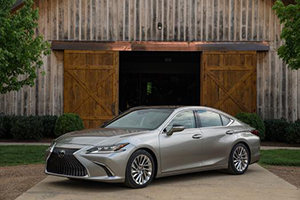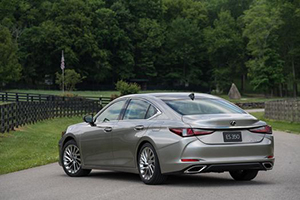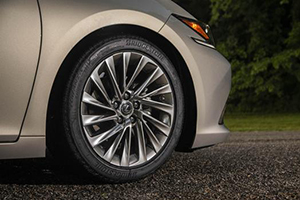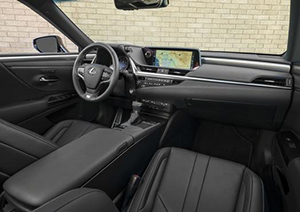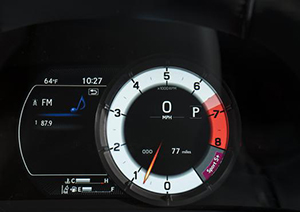2019 Lexus ES 350 Ultra Lux
The 2019 redesigned Lexus
ES 350 Ultra Lux is a top genuine luxury sedan.
Prices: $43,150
The Lexus ES humbly began life as the 1990 ES 250, which was a thinly
modified version of the Toyota Camry meant to back up the flagship
Lexus LS 400 luxury model. Lexus thought most would want the less
costly ES 250 but soon found seemingly everyone wanted the LS 400. I
was at the California media introduction of both cars in 1989 and the
ES 250 clearly was markedly inferior to the LS 400.
Years passed, and the ES became vastly improved and has long been a top
Lexus seller.
The seventh-generation ES 350 arrives as a redesigned 2019 model
that’s a solid revamp of its predecessor, with top
construction. It’s sportier because it is designed to attract
younger buyers—not that it should disappoint older ones.
There’s an all-new more-rigid chassis for a more dynamic look
and better handling. The new model is 2.6 inches longer, slightly lower
and 1.8 inches wider, with wheels pulled to its corners thanks to a 2
inch longer wheelbase at 103 inches and wider front and rear tracks.
This sleek four-door sedan now somewhat resembles a fastback model,
without a sacrifice in rear-seat headroom. Actually, headroom has been
slightly increased despite the sleek roofline through use of a lower
hip point and a carefully configured headliner.
The typical large, still somewhat-controversial Lexus signature grille
remains, although in modified form. And the sharply chiseled rear has
LED taillights that wrap around the quarter panels to provide a
continuous styling line. The large chromed, artfully shaped dual
exhaust tips are a definite visual plus.
The front-wheel-drive ES 350 comes in various trim levels, starting
with a $39,600 base model and going to the $43,150 Ultra Lux model that
I tested. Oh, there’s also a sportier $44,135 F Sport version
that’s new for 2019, but it has no additional horsepower. In
fact, no ES 350 can be called a sports sedan. It’s primarily
a solid luxury vehicle, despite its sound roadability. Nothing sloppy
here.
All ES 350 models come with a smooth 3.5-liter V-6 with high-pressure
injectors that generates 302 horsepower and 287 pound/feet of torque.
Despite near-identical displacement to its predecessor, it provides
approximately 20 more horsepower and 12 additional pound/feet of
torque.The compression ratio is a sky high (at least by old muscle car
standards) 11.8:1, but only 87 octane gasoline is needed.
The engine works with a smooth 8-speed automatic transmission with a
manual shift feature. The 0-60 m.p.h. time is a Lexus-claimed claimed
6.6 seconds. It actually felt a little faster.
There’s a 15.9-gallon gas tank, and estimated fuel economy is
22 miles per gallon the city and 33 on highways despite the
car’s 3,649-pound weight and lively performance in town and
on highways. (There’s also a $41,410-$45,060 ES 300h hybrid
model with a combined 215 total horsepower and a Lexus-estimated 44
combined mile-per-gallon figure.)
I found my test car’s fast, accurate steering to be a bit
heavy, perhaps as a result of the new rack-assist type Electric Power
Steering system. There was essentially little change in driving
characteristics when I put the car via driver-adjustable control in
“Eco,” “Normal” and
“Sport” modes. Basically, you just get higher revs
and a slightly firmer ride in “Sport” mode for
quicker engine response.
Handling is helped by a vehicle stability control system. The brake
pedal has a linear action that allows smooth stops with the anti-lock
braking system, which has electronic brake force distribution.
Safety features include side curtain air bags, a pre-collision system
with pedestrian and daytime bicycle detection, all-speed dynamic radar
cruise control, lane tracing assist, lane departure alert with steering
assist and road sign assist. If road markings aren’t
detected, the Lexus Safety System can, in certain conditions, follow
the vehicle ahead of it when used in conjunction with the Lexus
All-Speed Range Dynamic Radar Cruise Control system.
My test car’s options included the always-handy blind sport
monitor with rear cross-traffic alert, rear pedestrian detection and a
10.2-inch heads-up display that keeps a driver posted of such things as
speed limits. Other options included a navigation system with a
12.3-inch color multimedia display, upscale 17-speaker sound system,
heated wood and leather steering wheel and fast response interior
heater that I greatly appreciated on a cold Chicago day.
This is the first Lexus model to offer Apple CarPlay phone
functionality, letting drivers control their iPhones through the
dashboard display screen with Siri Eyes Free voice control.
All doors open wide to allow easy entry to the church-quiet, plush
interior, which has extra-supportive front heated and ventilated seats
and easily read backlit gauges. There’s a pushbutton start,
dual-zone automatic climate control and one-touch open/close power
tilt-and-slide sunroof. The steering wheel even has more fore/aft
adjustment and dashboard HIV vents have a unique design, showing good
attention to detail.
There is impressive occupant room, front and rear, and a good amount of
cabin storage areas.
However, the remote touch interface is frustrating to use, making the
infotainment system complicated and distracting. However,
there’s lots of small but clearly marked secondary manual
controls for the sound system and such.
The impressively large trunk has a wide opening and power open/close
feature. Cargo room has been increased. There’s now 16.7
cubic feet of trunk space with additional underfloor side pockets for
smaller items. However, the rear seatbacks don’t fold
forward. Instead there’s a large fold-down rear center
armrest with twin cupholders.
The hood glides open on twin structs, revealing a neatly designed
engine compartment with a huge plastic engine cover that seems to say
“Just check a few fluid levels, if you wish, then please go
away. We’re complicated.”
